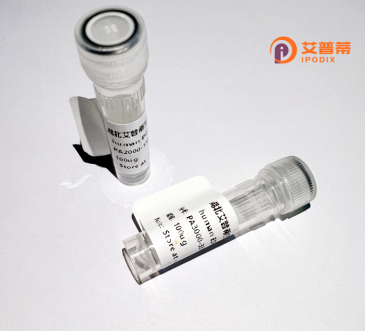
| 纯度 | >90%SDS-PAGE. |
| 种属 | Human |
| 靶点 | OTUD4 |
| Uniprot No | Q01804 |
| 内毒素 | < 0.01EU/μg |
| 表达宿主 | E.coli |
| 表达区间 | 1-401 aa |
| 活性数据 | MWAPHSYLYPLHQAYLAACRMYPKVPVPVYPHNPWFQEAPAAQNESDCTCTDAHFPMQTEASVNGQMPQPEIGPPTFSSPLVIPPSQVSESHGQLSYQADLESETPGQLLHADYEESLSGKNMFPQPSFGPNPFLGPVPIAPPFFPHVWYGYPFQGFIENPVMRQNIVLPSDEKGELDLSLENLDLSKDCGSVSTVDEFPEARGEHVHSLPEASVSSKPDEGRTEQSSQTRKADTALASIPPVAEGKAHPPTQILNRERETVPVELEPKRTIQSLKEKTEKVKDPKTAADVVSPGANSVDSRVQRPKEESSEDENEVSNILRSGRSKQFYNQTYGSRKYKSDWGYSGRGGYQHVRSEESWKGQPSRSRDEGYQYHRNVRGRPFRGDRRRSGMGDGHRGQHT |
| 分子量 | 71.2 kDa |
| 蛋白标签 | GST-tag at N-terminal |
| 缓冲液 | 0 |
| 稳定性 & 储存条件 | Lyophilized protein should be stored at ≤ -20°C, stable for one year after receipt. Reconstituted protein solution can be stored at 2-8°C for 2-7 days. Aliquots of reconstituted samples are stable at ≤ -20°C for 3 months. |
| 复溶 | Always centrifuge tubes before opening.Do not mix by vortex or pipetting. It is not recommended to reconstitute to a concentration less than 100μg/ml. Dissolve the lyophilized protein in distilled water. Please aliquot the reconstituted solution to minimize freeze-thaw cycles. |
以下是关于人OTUD4蛋白的3篇代表性文献的简要列举(注:内容基于公开研究信息概括,可能与实际文献存在偏差):
---
1. **文献名称**:OTUD4 coordinates DNA double-strand break repair via USP7-dependent RNF168 deubiquitination
**作者**:Nakamura K, et al.
**摘要**:揭示了OTUD4通过去泛素化酶活性调控RNF168的稳定性,协同USP7在DNA双链断裂修复中的关键作用,维持基因组稳定性。
---
2. **文献名称**:OTUD4 Deubiquitinates the NLRP3 Inflammasome to Restrain Caspase-1 Activation
**作者**:Zhou Y, et al.
**摘要**:研究发现OTUD4通过特异性去除NLRP3炎性体的泛素化修饰,抑制caspase-1激活及IL-1β分泌,从而调控先天免疫反应的过度激活。
---
3. **文献名称**:OTUD4 suppresses tumor metastasis via stabilizing PTEN protein in colorectal cancer
**作者**:Wang H, et al.
**摘要**:在结直肠癌中,OTUD4通过去泛素化稳定PTEN蛋白,抑制Wnt/β-catenin信号通路,进而遏制肿瘤细胞的迁移和侵袭能力。
---
如需获取准确文献,建议通过PubMed或Web of Science以“OTUD4”为关键词检索近年研究,重点关注其参与的信号通路(如DNA修复、免疫调控、癌症)及底物特异性机制。
OTUD4 (Ovarian Tumor Domain-Containing Protein 4) is a deubiquitinating enzyme (DUB) belonging to the OTU (Ovarian Tumor) protease superfamily. It plays a critical role in regulating cellular processes by removing ubiquitin chains from target proteins, thereby modulating their stability, localization, or activity. OTUD4 is evolutionarily conserved and ubiquitously expressed, with involvement in diverse pathways including DNA damage repair, immune signaling, apoptosis, and cell cycle regulation. Structurally, it contains a catalytic OTU domain responsible for its enzymatic activity and intrinsically disordered regions that facilitate interactions with substrates or regulatory partners.
Mechanistically, OTUD4 preferentially cleaves lysine-11 (K11)- and lysine-48 (K48)-linked polyubiquitin chains, exerting both pro- and anti-degradative effects depending on context. For instance, it stabilizes the tumor suppressor p53 by deubiquitination, enhancing genomic stability, while also regulating NF-κB signaling by targeting key components. Recent studies highlight its role in maintaining proteostasis under stress conditions and its interplay with autophagy. Dysregulation of OTUD4 has been implicated in cancers, neurodegenerative disorders, and autoimmune diseases. Notably, it acts as a tumor suppressor in certain cancers but displays oncogenic properties in others, underscoring its context-dependent functionality. Its emerging roles in antiviral immunity and inflammatory responses further broaden its therapeutic relevance. Despite progress, OTUD4's full substrate spectrum, tissue-specific regulation, and disease mechanisms remain active areas of investigation.
×